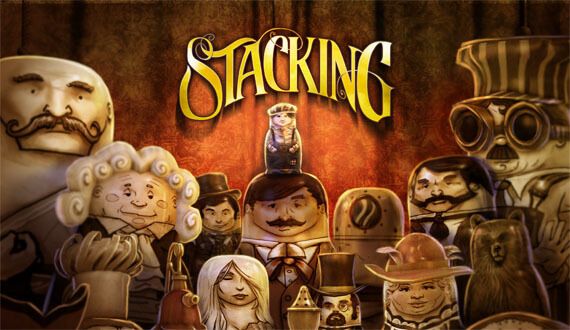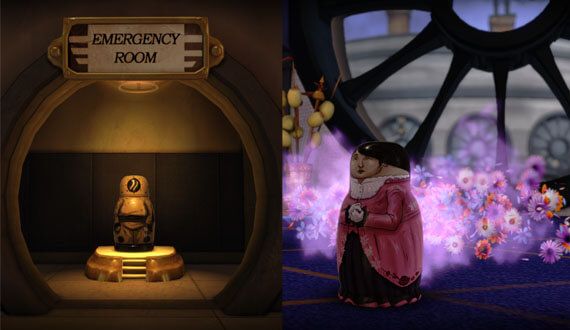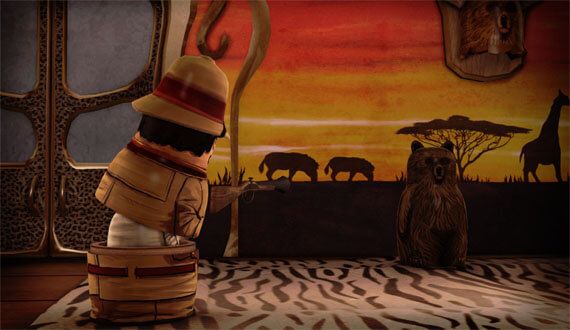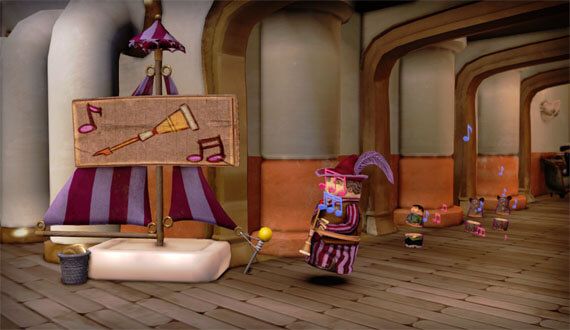Game Rant's Sebastian Gaweda reviews Stacking
Double Fine is known for being original, so in some ways Stacking shouldn't come as a surprise to fans of the developer. The game is unique and endearing - with the same unique development as prior Double Fine productions.
Though, the real question is, like many of Double Fine's past creations, whether or not this quirky adventure game is doomed to obscurity.
In Stacking players control Charlie Blackmore, the smallest matryoshka (Russian nesting) doll in the world. Stacking begins when Charlie's father gets a new job working for the Baron as the Master Chimney Sweep at his newest enterprise. After a couple of weeks, his father disappears and Charlie's family is forced to sell all their belongings. To make matters worse his brothers and sisters are forced into the workforce in order to pay off his family's debts.
As time passes, a letter from one of Charlie's brothers informs him that his siblings have been forced into slave labor and are in need rescue. Having a heart three times his size, and just as much courage, Charlie sets out to save his family from The Baron.
The first thing players will notice, in typical Double Fine fashion, is that Stacking has style. The game is set in the 1930s silent film era and everything in the game is consistent with this period. All cut-scenes are told with diorama sets used as a stage, and all dialogue is "spoken" in true silent film style through the use of title cards. Charlie's surrounding are populated with real world miniature items: suitcases are made from matchstick boxes, posts are made from sewing pins, and speared olives litter levels as decorative plants.
Charlie's small size makes it easy for everyone in the world to dismiss him, but his small stature is also his biggest strength. With the ability to stack into any doll, one size larger than he is, Charlie gains access to the abilities of the other dolls who inhabit the world. From tea time to farting, to even playing tag, abilities vary widely and, for the most part, are a lot of fun to exploit. Charlie uses these abilities to complete each level's various challenges - which are required to move the story forward.
One of the better features in Stacking is the ability to combine a pair of doll's abilities. For example, in order to complete one of the game's later challenges, the player needs to get a guard sick. One of the solutions involves dousing the guard in water with one doll, and blasting him with cold air using another. Unfortunately, this also a place where Stacking falls short. The number of abilities that can be combined are rather few and there aren't any combinations that involve more than two dolls. It would have been nice to have this take a more prominent role in the game.
In addition to challenges, the game tasks players with two optional goals, not essential for completing the story, but required for 100% completion.
The first feature has to do with finding all the game's "unique" dolls. Unique dolls are one of a kind and usually have exclusive abilities. Quite often, these abilities are the key to finding alternate solutions to challenges, or completing all the Hi-Jinks in a level (more on Hi-Jinks in a minute). These dolls help give the game personality and a lot of the unique dolls are memorable - it's obvious a lot of care was put into giving each one a unique purpose. Finding them all may not be difficult, but it does require a bit of clever thinking, because some need to be tricked before you can stack into them.
The second feature challenges players to complete "Hi-Jinks." Hi-Jinks are hidden goals that are fulfilled when the player completes a specific action. As an example, in the second level of the game the player is granted access to a doll that can slap other dolls. Slapping other dolls triggers the Hi-Jinks alert, and once the player has slapped enough dolls, that Hi-Jinks requirement is fulfilled. Ultimately, Hi-Jinks is the most fun part of Stacking because it rewards players for disrupting the lives of the other dolls in inventive ways.
Player-progress is also tracked in an interesting way. Apart from a completion counter, the player's travels, as well as discovered dolls, are chronicled by Levi, a hobo Charlie befriends early in the game. Levi adds these accomplishments to Charlie's hideout in the form of paintings and his own rendition of the dolls Charlie encounters. Why this hobo is so eager to help young Charlie Blackmore is never explored - and probably for the best. This is another way the game falters, as this room serves little purpose beyond cosmetically chronicling what the start menu already does.
Anyone expecting a challenge from Stacking will probably be disappointed. The game's difficulty is permanently set to easy, and while a hint system helps players find the alternate solutions to the game's challenges, it could have done without it. Beating the game should take about four to five hours - and earning 100% completion will likely take an additional two or three more.
The game's primary design flaws come in the form of a sometimes twitchy camera, bugs, and somewhat clunky controls. Quickly stacking in and out of dolls could cause the camera to become positioned in a way that made it impossible to see Charlie's doll stack. Meanwhile one bug allowed stacking into an area that was impossible to stack out of.
The controls, while tight most of the times, can be clunky as the dolls seems to move like, well, dolls. Whether or not this was intentional is no doubt a point of debate, but the result is sometimes finding it difficult to position Charlie correctly for the task at hand.
While Double Fine has once again outdone themselves by creating a unique and engaging experience, Stacking still feels like it could have been much better. The game passes by in a flash and that's mostly because it doesn't offer any real challenge. It's abundantly clear that they wanted to market this game to children, but even so, children above the age of seven will likely find little challenge here. For all the potential the game had, in premise, its execution focused too heavily on the art of stacking, and subsequently missed plenty of opportunities to give the game some real dimension (and make it more fun).
That being said, the novelty of stacking doesn't wear off quickly enough to be a problem for this short game, and the title is still worth a playthrough for any gamer looking for a fun stroll through a Double Fine world.
Stacking is available now for $14.99 on PSN, or free for a limited time if you have a PlayStation Plus account, and 1200 MS Points on Xbox Live Marketplace.





